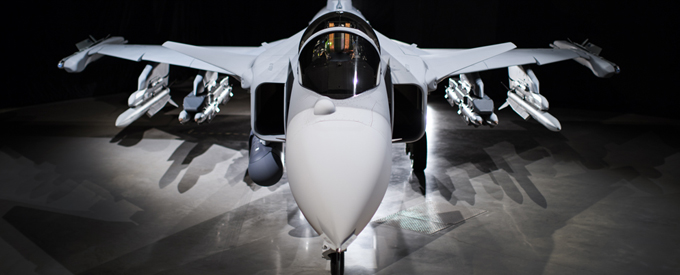2020-09-01
Enhancing Survivability Through Electronic Attack
A fighter aircraft on a mission operates in an environment full of threats, such as air and ground based radars and infrared- (IR) or radar-guided missiles. The aircraft is equipped with systems that enable the crew to complete their mission successfully and ensure they can return safely to the base. This is referred to as the Electronic Warfare (EW) system.
Saab has developed a capable EW system for fighters on the market such as Arexis. It features Radar Warning Receivers (RWR) that detect radar emissions, as well as Intelligence, Surveillance and Reconnaissance (ISR) capabilities that enable tactical support. In combination with Electronic Counter Measures (ECM), which are used to deceive the opponent’s radars and other detection systems, this enhances the survivability of the platform.
Arexis is based on wideband digital technology specifically developed for robustness in today’s very complex signal environment. The core technologies in the system include ultra-wideband digital receivers, digital radio frequency memory devices for jamming, Gallium Nitride (GaN) solid state Active Electronically Scanned Array (AESA) jammer transmitters, and interferometric direction finding systems.
Role-specific Solution
Arexis provides the aircrew with essential situational awareness for self-protection thanks to its RWR, and tactical support via its ISR capabilities. The situational awareness provided enhances the survivability of the platform together with the aid of the appropriate ECM.
Arexis products are adapted to fighter aircraft installation and environmental requirements. The architecture supports multi-function integration with other fighter aircraft sensors and countermeasures. One version of Arexis will be installed on board the new version of the Gripen fighter, Gripen E/F.
Furthermore, it includes an advanced Electronic Attack (EA) application, with EW technologies adapted to the lower frequency ranges that are required to jam modern anti-stealth air defence systems. The EA application provides high output power and is packed in a pod to make it a role-specific solution.
Complementing EW Capabilities
Avoiding detection is key to most air operations. Anti-Access/Area Denial (A2/AD) zones, protected by long-range integrated air defence systems are a major threat to flight operations. These air defence systems include radars operating at low frequencies, which makes them very difficult to detect even by modern fighter platforms.
Another element of the modern threat scenario is the battle between stealth and counter-stealth technologies. This has resulted in the re-emergence of surveillance radars at very low frequency bands. This is where Saab’s new Electronic Attack Jammer Pod (EAJP) comes in.
The EAJP can act as a strong complement to the built-in electronic warfare capabilities on a fighter. Like all Arexis products, the pod is adapted to support multi-function integration with other fighter aircraft sensors and countermeasures.
“The pod involves the offensive use of electromagnetic energy to attack hostile radar systems, with the intent of degrading and neutralising the enemy’s combat capability by hiding or diffusing the image of the fighters to the radars,” said Jonas Grönberg, head of fighter EW marketing and sales at Saab.
The EAJP intercepts radio frequency signals from radars within a wide frequency band, generating and transmitting jamming signals back toward the radars. Its main role is to operate as an escort jammer, jamming all search and acquisition radar systems from inside or close to an attacking fighter formation.
“The jammer pod injects masking and saturation jamming into the main beam and the near side lobes of a radar, thereby enabling a safe sector for the striking formation, severely reducing the situational awareness of fighters for the air defence radar systems,”, added Grönberg.
AESA technology, which is used in the EAJP, means the beam of the radio waves can be electronically steered in different directions without physically moving the antenna and this makes the radar beams stealthier, more agile and powerful.
Saab performed the first flight test with a demonstrator of the EAJP on a Gripen D in late 2019, just 26 months after the project start. The aim of the project is to develop a demonstrator version of a serial pod integrated on a Gripen fighter for flight trials.
“The project, which has been incredibly successful since the start, reuses technology and building blocks from the ongoing development of the Gripen E/F electronic warfare system,” Grönberg concluded.


No Comments